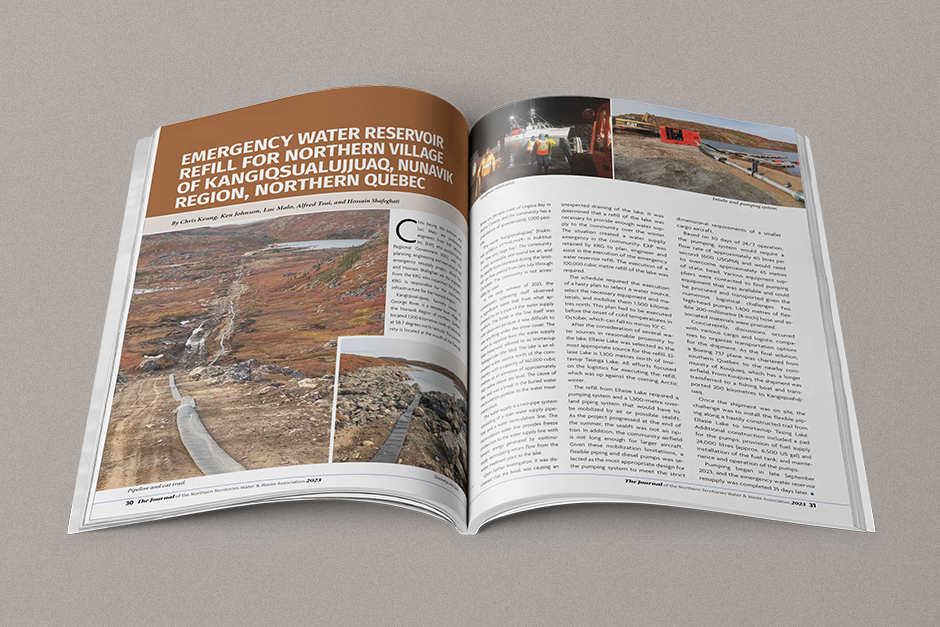By: Process Engineer Chris Keung, Director of Arctic Engineering Ken Johnson, Project Manager Luc Malo, Alfred Tsui and Hossain Shafeghati
Kangiqsualujjuaq, formerly known as George River, is a remote Inuit village in the Nunavik Region of northern Quebec, located 1,500 kilometres north of Montreal at 58.7 degrees north latitude. The community is located at the mouth of the George River on the east coast of Ungava Bay in Arctic Canada, and the community has a population of approximately 1,000 people.
The name “Kangiqsualujjuaq” is Inuktitut for “the very large bay”. The community is only accessible year-round by air, and by sealift from Montreal during the limited ice-free period from late July through October. The community is not accessible by road.
In the early summer of 2023, the community operating staff observed a significant water leak from what appeared to be a pipe of the water supply system. The break in the line itself was not observed because it was difficult to see anything under the snow cover. The water is supplied from the water supply lake (reservoir) referred to as Imirtaviup Tasinga Lake (the lake). The lake is an elevated water source north of the community with a capacity of 360,000 cubic metres at an elevation of approximately 140 metre above sea level. The cause of the leak was a break in the buried water recirculation pipeline to the water treatment plant.
The water supply is a two-pipe system consisting of a main water supply pipeline and a water recirculation line. The recirculation water line provides freeze protection to the water supply line with kinetic energy generated by continuously recirculating return flow from the water treatment plant to the lake.
Upon further investigation, it was discovered that the break was causing an unexpected draining of the lake. It was determined that a refill of the lake was necessary to provide enough water supply to the community over the winter. The situation created a water supply emergency in the community. EXP was retained by KRG to plan, engineer and assist in the execution of the emergency water reservoir refill. The execution of a 100,000 cubic metre refill of the lake was required.
The schedule required the execution of a hasty plan to select a water source, select the necessary equipment and materials, and mobilize them 1,500 kilometres north. This plan had to be executed before the onset of cold temperatures in October, which can fall to minus 10° C.
After the consideration of several water sources in reasonable proximity to the lake, Ellasie Lake was selected as the most appropriate source for the refill. Ellasie Lake is 1,300 metres north of Imirtaviup Tasinga Lake. All efforts focused on the logistics for executing the refill, which was up against the coming Arctic winter.
The refill from Ellasie Lake required a pumping system and a 1,300-metre overland piping system that would have to be mobilized by air or possible sealift. As the project progressed at the end of the summer, the sealift was not an option. In addition, the community airfield is not long enough for larger aircraft. Given these mobilization limitations, a flexible piping and diesel pumps was selected as the most appropriate design for the pumping system to meet the strict dimensional requirements of a smaller cargo aircraft.
Based on 30 days of 24/7 operation, the pumping system would require a flow rate of approximately 40 litres per second (600 USGPM) and would need to overcome approximately 65 metres of static head. Various equipment suppliers were contacted to find pumping equipment that was available and could be procured and transported given the numerous logistical challenges. Two high-head pumps, 1,400 metres of flexible 200-millimetre (8-inch) hose and associated materials were procured.
Concurrently, discussions occurred with various cargo and logistic companies to organize transportation options for the shipment. As the final solution, a Boeing 737 plane was chartered from southern Quebec to the nearby community of Kuujjuaq, which has a longer airfield. From Kuujjuaq, the shipment was transferred to a fishing boat and transported 200 kilometres to Kangiqsualujjuaq.
Once the shipment was on site, the challenge was to install the flexible piping along a hastily constructed trail from Ellasie Lake to Imirtaviup Tasing Lake. Additional construction included a pad for the pumps; provision of fuel supply 24,000 litres (approx. 6,500 US gal) and installation of the fuel tank; and maintenance and operation of the pumps. Pumping began in late September 2023, and the emergency water reservoir resupply was completed 35 days later.
Originally published in the 2023 edition of the Journal of Northern Territories Water and Waste Association.

